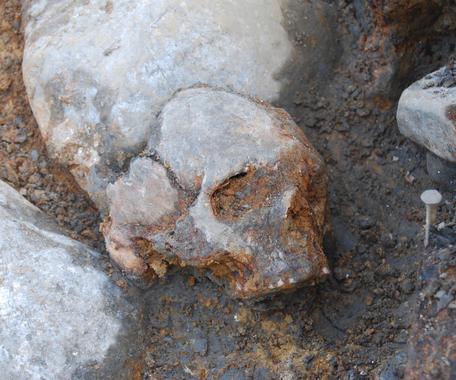 |
| This skull of a 7,000-year-old German farmer was among the ancient human bones that revealed more about the genetic heritage of present-day Europeans. Image: Joanna Drath/University of Tübingen |
The setting: Europe, about 7,500 years ago.
Agriculture was sweeping in from the Near East, bringing early farmers into contact with hunter-gatherers who had already been living in Europe for tens of thousands of years.
Genetic and archaeological research in the last 10 years has revealed that almost all present-day Europeans descend from the mixing of these two ancient populations. But it turns out that’s not the full story.
Researchers at Harvard Medical School and the University of Tübingen in Germany have now documented a genetic contribution from a third ancestor: Ancient North Eurasians. This group appears to have contributed DNA to present-day Europeans as well as to the people who travelled across the Bering Strait into the Americas more than 15,000 years ago.
“Prior to this paper, the models we had for European ancestry were two-way mixtures. We show that there are three groups,” said David Reich, professor of genetics at HMS and co-senior author of the study. [...] harvard.edu/ / Link 2
More information: Ancient human genomes suggest three ancestral populations for present-day Europeans, Nature, dx.doi.org/10.1038/nature13673
Actualización: Los europeos modernos descienden de tres grupos de antepasados distintos / SINC
Los orígenes de los habitantes actuales de Europa se remontan a tres poblaciones humanas ancestrales: cazadores-recolectores, primeros agricultores, y a una tercera población no descrita hasta ahora, según un artículo que publica la revista Nature en portada y en el que han participado las universidades Pompeu Fabra y de Santiago de Compostela.
 |
| Cráneo de mujer del yacimiento de Kanaljorden en Motala (Suecia), excavado entre 2009 y 2013. / Fredrik Hallgren. |
El comienzo de la agricultura y la domesticación de animales, que se inició en Oriente Próximo hace 11.000 años, tuvo un gran impacto en la vida humana. En muchos lugares, los cazadores-recolectores fueron reemplazados por los agricultores sedentarios y hubo un considerable aumento en el tamaño de las poblaciones, lo que sentó las bases para la formación de grandes ciudades y sociedades complejas.
La evidencia arqueológica sugiere que en el centro de Europa, la transición a un estilo de vida agrícola se produjo hace 7.500 años aproximadamente, con la aparición de la Linearbandkeramik (LBK), una cultura agrícola sedentaria...
Actualización 11-11-14: Supercomputing Beyond Genealogy Reveals Surprising European Ancestors - Texas Advanced Computing Center
What if you researched your family's genealogy, and a mysterious stranger turned out to be an ancestor?
That's the surprising feeling had by a team of scientists who peered back into Europe's murky prehistoric past thousands of years ago. With sophisticated genetic tools, supercomputing simulations and modeling, they traced the origins of modern Europeans to three distinct populations.
The international research team published their September 2014 results in the journal Nature...
Actualización 20-01-15: Descubren el tercer linaje asociado al genoma europeo actual | CONICET
Un análisis de ADN antiguo demostró que los europeos tienen genes de tres poblaciones humanas ancestrales y no dos como se creía. Especialistas del CONICET aportaron sus conocimientos...







3 comentarios:
Actualización: Los europeos modernos descienden de tres grupos de antepasados distintos
Actualización: Supercomputing Beyond Genealogy Reveals Surprising European Ancestors - Texas Advanced Computing Center
Actualización: Descubren el tercer linaje asociado al genoma europeo actual | CONICET
Publicar un comentario